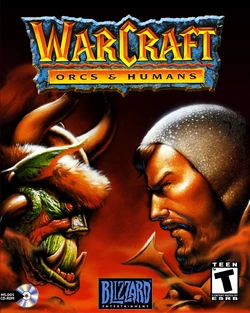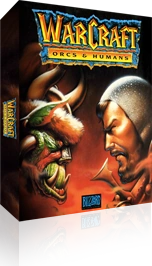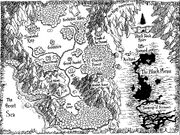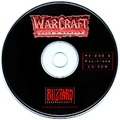mNo edit summary |
mNo edit summary |
||
| Line 3: | Line 3: | ||
|name = ''Warcraft: Orcs & Humans'' |
|name = ''Warcraft: Orcs & Humans'' |
||
| image = Warcraft I - Cover.jpg |
| image = Warcraft I - Cover.jpg |
||
| − | | caption = |
+ | | caption = Box art |
| developer = [[Blizzard Entertainment]] |
| developer = [[Blizzard Entertainment]] |
||
| publisher = NA: Blizzard Entertainment<br />EU: {{wplink|Interplay Entertainment}} |
| publisher = NA: Blizzard Entertainment<br />EU: {{wplink|Interplay Entertainment}} |
||
Revision as of 21:27, 5 March 2018
| Warcraft: Orcs & Humans | |
|---|---|
 Box art | |
| Developer(s) | Blizzard Entertainment |
| Publisher(s) |
NA: Blizzard Entertainment EU: Interplay Entertainment |
| Platforms | MS-DOS, Classic Mac OS, PC-9800 |
| Release |
MS-DOS: November 23, 1994[1] Mac: Early 1996 PC-9800: December 2, 1995 |
| Latest release |
1.22h (MS-DOS) 1.06 (Mac) |
| Genre(s) | Real-time strategy |
Warcraft: Orcs & Humans (or Warcraft I) is the first video game in the Warcraft series. It was released in 1994 and quickly became a best seller.[2] The game features two races, the humans of the Kingdom of Azeroth and the invading orcs of the Orcish Horde. Currently, the game is out of print and the demo that was once available on Blizzard Entertainment's site is no more.
The game was eventually followed up with a direct sequel, Warcraft II: Tides of Darkness, and later a whole universe of games, novels and comic books.
The game sold 100,000 copies in its first year, making it Blizzard's best selling title at its time of release.[3]
Overview

The official box for Warcraft: Orcs & Humans.
Warcraft: Orcs & Humans has not only became a classic, winning many awards, but has also set new standards for multiplayer games. Set in the mythic Kingdom of Azeroth, players are given the task of maintaining a thriving economy while building a war machine with which to destroy the enemy.
By playing either as a Human or as an Orc in this saga, two separate story lines evolve with 12 missions per side, each telling a different tale in the battle for Azeroth. From swords to sorcery, all the elements of classic fantasy are here to explore; rich forests, dark dungeons and bubbling swamps await the stalwart troops amassed to fight for dominance.
The multiplayer aspects of the game bring Warcraft to a new level of excitement. A player can challenge another one on over 20 custom maps and determine who is the supreme warlord. Head to head play is supported over modem, serial link, and IPX networks, and works cross-platform with both the IBM-PC and Macintosh versions.[2]
Warcraft: Orcs & Humans laid out the foundations for many of the tropes that would later become recurrent in the series: emphases on skillful management of relatively small forces, a living universe that is detailed both through in-game cutscenes and a rich user manual, dungeon maps, civil war maps, the presence of creeps creatures, units responding humorously when clicking on them repeatedly. Unlike in Warcraft III: Reign of Chaos, units and buildings in both of the armies have mostly the same functions and stats but with different sprites.
Multiplayer and AI skirmishes that are not part of campaigns were supported by a random map generator.[4]
History

Map of Azeroth.

In-game map of Azeroth.
- Main articles: First War, Warcraft: Orcs & Humans missions
Before the start of the First War, the orcs, originating from the world of Draenor, were corrupted by the Burning Legion to form the mighty Horde. They slaughtered the other races of their planet, but their desire for bloodlust remained insatiable. Their leader Gul'dan joined forces with the Last Guardian Medivh, who was corrupted by the demon lord Sargeras, to open a portal to another world called Azeroth.
From that point on, the orc campaign involves the orcish Horde's attacks on the humans and other forces of this world. After many battles and through a war of attrition, the Horde eventually overwhelms the human kingdom of Azeroth, and later chooses to pursue the survivors across the seas to the north. The city of Stormwind is destroyed in the final battle of the campaign.
The human campaign is an alternate history in which the humans successfully defend their kingdom against the Horde and pushes the orcs back to their main fortress at Blackrock Spire. Its destruction signals the end of the human campaign.
Later games consider that the result of the First War was an orcish victory (the orc campaign end), but with several plot points taken from the human campaign. As a result, a great part of the history was retconned with later games; for a full list of changes, see here.
Requirements

In the Age of Chaos...

No one knew where these creatures came from...
MS-DOS System Requirements
- Computer:
- Warcraft requires at least an IBM 386 - 20 Mhz (or 100% compatible) and at least 4 MB RAM.
- Controls:
- You will need a Mouse (100% Microsoft compatible) and Keyboard to play Warcraft.
- Display:
- Warcraft requires a colour monitor with a VGA graphics system. If you are using a compatible graphics card/monitor, it must be 100% compatible with VGA systems.
- Disk Drives:
- CD-ROM Version: A CD-ROM drive and a Hard Disk are required for installation and play.
- Diskette Version: A 3.5″ Disk Drive and a Hard Disk are required for installation and play.
- DOS:
- You must have MS-DOS version 3.2 or higher.
- Sound:
- Warcraft supports General Midi, Soundblaster, Adlib, Pro Audio Spectrum and Compatibles.[5]
Mac OS System Requirements
- Computer:
- Warcraft requires at least a Macintosh 68030 processor (68040 recommended) and at least 8 MB RAM. Warcraft is also accelerated for Power Macintosh.
- Controls:
- You will need a Mouse and Keyboard to play Warcraft.
- Display:
- Warcraft requires a 13" colour monitor with 256 colours and Quicktime 2.0 or greater.
- Disk Drives:
- A CD-ROM drive and a Hard Disk are required for installation and play.
- System:
- You must have System 7.0 or greater (7.1 or greater recommended).
- Sound:
- Sound Manager 3.1 or greater.
- Two-Player Support:
- Warcraft requires Communication Toolbox tools for 2-player mode.[6]
Development
Inspired by Dune II,[7][8] work on the game began in 1993. Aiming to create "the high fantasy version of [Dune II]" with "battle axes and orcs",[8] influence was taken from Lord of the Rings, Conan, Dungeons and Dragons, and other classical fantasy tropes. This was mixed with "a 90s comic sensibility" with hyper-proportional, colorful characters.[9] Warcraft marked the beginning of the "Blizzard (art) Style," to go against photorealism in games.[10] The name "Warcraft" was originated by artist Samwise Didier, when he shouted it out during a lunchtime brainstorming session.[8]
Blizzard co-founder Allen Adham originally hoped to obtain a license to the Warhammer universe to try to increase sales by brand recognition. Warhammer was a huge inspiration for the art-style of Warcraft, but a combination of factors, including a lack of traction on business terms and a desire on the part of the rest of the development team to control their own universe nixed any potential for a deal.[11]
At BlizzCon 2013, J. Allen Brack announced that several people were working on a side project to update the old Warcraft games for modern computers.[12][13] At BlizzCon 2016 however, Frank Pearce stated that while the game was now playable on modern systems, there were no plans to remaster it.[14]
Gallery
- Screenshots
- Wallpapers
- Miscellaneous
Awards
- Main article: Blizzard Entertainment
Videos
Notes & trivia
- Just like the "World of Warcraft" name already appeared in Warcraft: Orcs & Humans ("welcome to the world of Warcraft"), the "Battle for Azeroth" one was already used in Warcraft II ("The battle for Azeroth continues over land, sea and air").
References
- ^ Geryk, B. 2009-11-15. GameSpot Presents: A History of Real-Time Strategy Games – The First Wave. Gamespot. Archived from the original on 2009-11-20. Retrieved on 2018-03-04.
- ^ a b Warcraft: Orcs and Humans. Retrieved on 1996-10-19.
- ^ Frank: Warcraft!, Blizzard Entertainment. Retrieved on 2017-07-10
- ^ Warcraft: Orcs & Humans manual
- ^ Entertainment, Blizzard. "Getting Started", Warcraft: Orcs & Humans Manual (DOS version), 1.
- ^ Entertainment, Blizzard. "Getting Started", Warcraft: Orcs & Humans Manual (Mac version), 1.
- ^ 2014-05-21, Blizzard set out to make a StarCraft mod, and instead reinvented gaming's most popular genre. Polygon, retrieved on 2014-06-07
- ^ a b c BlizzCon 2017, "Behind Blizzard's Worlds"
- ^ 2013-03-16, Blizzard Exec Chris Metzen Explains How Fan Art Has Influenced Diablo To StarCraft. Forbes, retrieved on 2015-03-02
- ^ 2017-04-27, Rock and Roll Days of StarCraft: a Development Retrospective. Blizzard Entertainment, retrieved on 2017-04-29
- ^ Kotaku - How Warcraft Was Almost a Warhammer Game (and how That Saved WoW)
- ^ Kyle Hilliard 2013-11-10. Blizzard Working On Bringing Warcraft & Warcraft II To Modern PCs. Gameinformer. Retrieved on 2014-01-03.
- ^ BlizzCon 2013 World of Warcraft Q&A Panel
- ^ 2016-11-06, Blizzard isn't planning to remaster Warcraft 1 and 2. Eurogamer, retrieved on 2016-11-30
External links
 Blizzard Entertainment Legacy Games (US)
Blizzard Entertainment Legacy Games (US) Blizzard Entertainment Legacy Games (Europe)
Blizzard Entertainment Legacy Games (Europe) Wikipedia Warcraft: Orcs & Humans on Wikipedia
Wikipedia Warcraft: Orcs & Humans on Wikipedia
| ||||||||||||||
| |||||||||||||||||||||||||||||||||||||||||||||||||||||||






